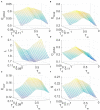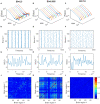Optimal Organization of Functional Connectivity Networks for Segregation and Integration With Large-Scale Critical Dynamics in Human Brains
- PMID: 33867963
- PMCID: PMC8044315
- DOI: 10.3389/fncom.2021.641335
Optimal Organization of Functional Connectivity Networks for Segregation and Integration With Large-Scale Critical Dynamics in Human Brains
Abstract
The optimal organization for functional segregation and integration in brain is made evident by the "small-world" feature of functional connectivity (FC) networks and is further supported by the loss of this feature that has been described in many types of brain disease. However, it remains unknown how such optimally organized FC networks arise from the brain's structural constrains. On the other hand, an emerging literature suggests that brain function may be supported by critical neural dynamics, which is believed to facilitate information processing in brain. Though previous investigations have shown that the critical dynamics plays an important role in understanding the relation between whole brain structural connectivity and functional connectivity, it is not clear if the critical dynamics could be responsible for the optimal FC network configuration in human brains. Here, we show that the long-range temporal correlations (LRTCs) in the resting state fMRI blood-oxygen-level-dependent (BOLD) signals are significantly correlated with the topological matrices of the FC brain network. Using structure-dynamics-function modeling approach that incorporates diffusion tensor imaging (DTI) data and simple cellular automata dynamics, we showed that the critical dynamics could optimize the whole brain FC network organization by, e.g., maximizing the clustering coefficient while minimizing the characteristic path length. We also demonstrated with a more detailed excitation-inhibition neuronal network model that loss of local excitation-inhibition (E/I) balance causes failure of critical dynamics, therefore disrupting the optimal FC network organization. The results highlighted the crucial role of the critical dynamics in forming an optimal organization of FC networks in the brain and have potential application to the understanding and modeling of abnormal FC configurations in neuropsychiatric disorders.
Keywords: DTI; E/I ratio; Greenberg-Hasting model; criticality; fMRI; functional connection networks.
Copyright © 2021 Zhou, Ma, Song, Wu, Liu, Liu, Yu and Feng.
Conflict of interest statement
The authors declare that the research was conducted in the absence of any commercial or financial relationships that could be construed as a potential conflict of interest.
Figures








Similar articles
-
Maximal flexibility in dynamic functional connectivity with critical dynamics revealed by fMRI data analysis and brain network modelling.J Neural Eng. 2019 Jul 23;16(5):056002. doi: 10.1088/1741-2552/ab20bc. J Neural Eng. 2019. PMID: 31071699
-
Resting state networks in empirical and simulated dynamic functional connectivity.Neuroimage. 2017 Oct 1;159:388-402. doi: 10.1016/j.neuroimage.2017.07.065. Epub 2017 Aug 3. Neuroimage. 2017. PMID: 28782678
-
Modular co-organization of functional connectivity and scale-free dynamics in the human brain.Netw Neurosci. 2017 Jun 1;1(2):143-165. doi: 10.1162/NETN_a_00008. eCollection 2017 Spring. Netw Neurosci. 2017. PMID: 29911674 Free PMC article.
-
The structural and functional connectivity of the posterior cingulate cortex: comparison between deterministic and probabilistic tractography for the investigation of structure-function relationships.Neuroimage. 2014 Nov 15;102 Pt 1:118-27. doi: 10.1016/j.neuroimage.2013.12.022. Epub 2013 Dec 21. Neuroimage. 2014. PMID: 24365673 Review.
-
Using resting state functional connectivity to unravel networks of tinnitus.Hear Res. 2014 Jan;307:153-62. doi: 10.1016/j.heares.2013.07.010. Epub 2013 Jul 26. Hear Res. 2014. PMID: 23895873 Review.
Cited by
-
Dopaminergic Modulation of Local Non-oscillatory Activity and Global-Network Properties in Parkinson's Disease: An EEG Study.Front Aging Neurosci. 2022 Apr 29;14:846017. doi: 10.3389/fnagi.2022.846017. eCollection 2022. Front Aging Neurosci. 2022. PMID: 35572144 Free PMC article.
-
The Task Pre-Configuration Is Associated With Cognitive Performance Evidence From the Brain Synchrony.Front Comput Neurosci. 2022 May 6;16:883660. doi: 10.3389/fncom.2022.883660. eCollection 2022. Front Comput Neurosci. 2022. PMID: 35603133 Free PMC article.
References
LinkOut - more resources
Full Text Sources
Other Literature Sources

